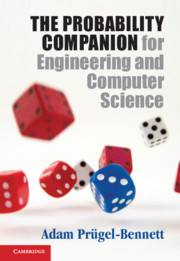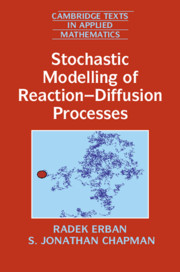Refine search
Actions for selected content:
980 results in Applied probability and stochastic networks
Bibliography
-
- Book:
- The Probability Companion for Engineering and Computer Science
- Published online:
- 03 January 2020
- Print publication:
- 23 January 2020, pp 449-453
-
- Chapter
- Export citation
7 - Mathematics of Random Variables
-
- Book:
- The Probability Companion for Engineering and Computer Science
- Published online:
- 03 January 2020
- Print publication:
- 23 January 2020, pp 132-186
-
- Chapter
- Export citation
9 - Entropy
-
- Book:
- The Probability Companion for Engineering and Computer Science
- Published online:
- 03 January 2020
- Print publication:
- 23 January 2020, pp 258-292
-
- Chapter
- Export citation
A - Answers to Exercises
-
- Book:
- The Probability Companion for Engineering and Computer Science
- Published online:
- 03 January 2020
- Print publication:
- 23 January 2020, pp 391-444
-
- Chapter
- Export citation
3 - Monte Carlo
-
- Book:
- The Probability Companion for Engineering and Computer Science
- Published online:
- 03 January 2020
- Print publication:
- 23 January 2020, pp 45-58
-
- Chapter
- Export citation
8 - Bayes
-
- Book:
- The Probability Companion for Engineering and Computer Science
- Published online:
- 03 January 2020
- Print publication:
- 23 January 2020, pp 187-257
-
- Chapter
- Export citation
2 - Survey of Distributions
-
- Book:
- The Probability Companion for Engineering and Computer Science
- Published online:
- 03 January 2020
- Print publication:
- 23 January 2020, pp 25-44
-
- Chapter
- Export citation
Nomenclature
-
- Book:
- The Probability Companion for Engineering and Computer Science
- Published online:
- 03 January 2020
- Print publication:
- 23 January 2020, pp xiii-xvi
-
- Chapter
- Export citation
12 - Stochastic Processes
-
- Book:
- The Probability Companion for Engineering and Computer Science
- Published online:
- 03 January 2020
- Print publication:
- 23 January 2020, pp 349-390
-
- Chapter
- Export citation
6 - Handling Experimental Data
-
- Book:
- The Probability Companion for Engineering and Computer Science
- Published online:
- 03 January 2020
- Print publication:
- 23 January 2020, pp 110-131
-
- Chapter
- Export citation
Index
-
- Book:
- The Probability Companion for Engineering and Computer Science
- Published online:
- 03 January 2020
- Print publication:
- 23 January 2020, pp 454-458
-
- Chapter
- Export citation
Frontmatter
-
- Book:
- The Probability Companion for Engineering and Computer Science
- Published online:
- 03 January 2020
- Print publication:
- 23 January 2020, pp i-iv
-
- Chapter
- Export citation

The Probability Companion for Engineering and Computer Science
-
- Published online:
- 03 January 2020
- Print publication:
- 23 January 2020

Stochastic Modelling of Reaction–Diffusion Processes
-
- Published online:
- 04 November 2019
- Print publication:
- 30 January 2020
Index
-
- Book:
- Applied Stochastic Differential Equations
- Published online:
- 16 April 2019
- Print publication:
- 02 May 2019, pp 311-316
-
- Chapter
- Export citation
Symbols and Abbreviations
-
- Book:
- Applied Stochastic Differential Equations
- Published online:
- 16 April 2019
- Print publication:
- 02 May 2019, pp 293-304
-
- Chapter
- Export citation
2 - Some Background on Ordinary Differential Equations
-
- Book:
- Applied Stochastic Differential Equations
- Published online:
- 16 April 2019
- Print publication:
- 02 May 2019, pp 4-22
-
- Chapter
- Export citation
List of Examples
-
- Book:
- Applied Stochastic Differential Equations
- Published online:
- 16 April 2019
- Print publication:
- 02 May 2019, pp 305-308
-
- Chapter
- Export citation
4 - Itô Calculus and Stochastic Differential Equations
-
- Book:
- Applied Stochastic Differential Equations
- Published online:
- 16 April 2019
- Print publication:
- 02 May 2019, pp 42-58
-
- Chapter
- Export citation
11 - Parameter Estimation in SDE Models
-
- Book:
- Applied Stochastic Differential Equations
- Published online:
- 16 April 2019
- Print publication:
- 02 May 2019, pp 234-250
-
- Chapter
- Export citation
